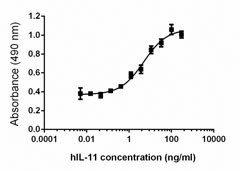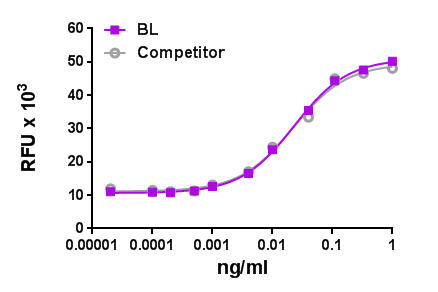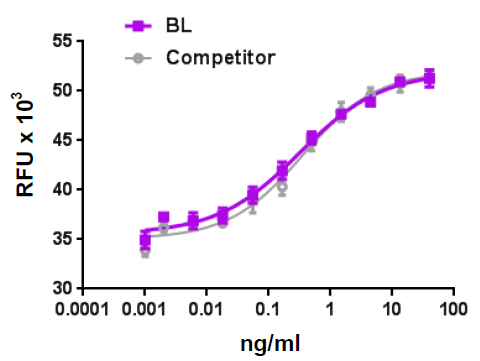- Regulatory Status
- RUO
- Other Names
- Adipogenesis Inhibitory Factor (AGIF)
- Ave. Rating
- Submit a Review
- Product Citations
- publications

-

7TD1 cell proliferation induced by human IL-11.
IL-11, a member of the IL-6 family of cytokines, exerts a wide range of biological effects on various cell types including hematopoietic cells, hepatocytes, adipocytes, neurons, and osteoblasts. IL-11 works synergistically with other growth factors including SCF, IL-4, IL-3, IL-7, IL-12, IL-13, and GM-CSF to stimulate the proliferation of cells from several hematopoietic lineages. Binding of IL-11 to IL-11 receptor (IL-11R) induces membrane bound gp130 homodimerization and triggers STAT3 phosphorylation by JAK. IL-11 shares the common receptor subunit gp130 with IL-6, IL-27, LIF, OSM, CNTF, CT-1, CLC, and NP. Female mice deficient in IL-11R revealed an important role for IL-11 in embryonic implantation. In addition, IL-11 shows anti-inflammatory activity in models of inflammatory bowel disease, chemotherapy induced oral mucositis, and inflammatory arthritis. IL-11 and IL-13 are highly expressed in asthmatic airways (Th2 response), and IL-11 can inhibit Th1 responses and inhibits the production of Th1 cytokines such as IL-12 and shifts inflammation in Th2 direction. Elevated IL-11 expression is associated with tumor grade and invasion in gastric cancer. Recombinant human IL-11 has been clinically approved to improve platelet recovery after chemotherapy-induced thrombocytopenia.
Product DetailsProduct Details
- Source
- Human IL-11, 180 amino acids Val20-Leu199 (Accession# P20809.1) was expressed in 293E.
- Molecular Mass
- The 180 amino acid recombinant protein has a predicted molecular mass of approximately 19.3 kD. The DTT-reduced and non reduced proteins migrate at approximately 19.3 kD by SDS-PAGE. The N-terminal amino acid is Valine.
- Purity
- >98%, as determined by Coomassie stained SDS-PAGE.
- Formulation
- 0.22 µm filtered protein solution is in PBS.
- Endotoxin Level
- Less than 0.01 ng per µg cytokine as determined by the LAL method.
- Concentration
- 10 and 25 µg sizes are bottled at 200 µg/mL. 100 µg size and larger sizes are lot-specific and bottled at the concentration indicated on the vial. To obtain lot-specific concentration and expiration, please enter the lot number in our Certificate of Analysis online tool.
- Storage & Handling
- Unopened vial can be stored between 2°C and 8°C for up to 2 weeks, at -20°C for up to six months, or at -70°C or colder until the expiration date. For maximum results, quick spin vial prior to opening. The protein can be aliquoted and stored at -20°C or colder. Stock solutions can also be prepared at 50 - 100 µg/mL in appropriate sterile buffer, carrier protein such as 0.2 - 1% BSA or HSA can be added when preparing the stock solution. Aliquots can be stored between 2°C and 8°C for up to one week and stored at -20°C or colder for up to 3 months. Avoid repeated freeze/thaw cycles.
- Activity
- The ED50 is 4-12 ng/ml, corresponding to a specific activity 8.3 x 104 - 2.5 x 105 units/mg, as determined by a dose-dependent stimulation of 7TD1 cells proliferation.
- Application
-
Bioassay
- Application Notes
-
BioLegend carrier-free recombinant proteins provided in liquid format are shipped on blue-ice. Our comparison testing data indicates that when handled and stored as recommended, the liquid format has equal or better stability and shelf-life compared to commercially available lyophilized proteins after reconstitution. Our liquid proteins are verified in-house to maintain activity after shipping on blue ice and are backed by our 100% satisfaction guarantee. If you have any concerns, contact us at tech@biolegend.com.
Antigen Details
- Structure
- "four-helix bundle" protein which folds similarly to IL-6.
- Distribution
-
IL-11 can be secreted by various cell types including epithelial, endothelial, keratinocytes, stromal, neuronal, fibroblasts, osteoclasts, and bone marrow stromal cells.
- Function
- IL-11, a multifunctional cytokine, plays important roles in hemopoiesis, thrombopoiesis, megakaryocytopoiesis, and bone resorption; It regulates macrophage differentiation and confers mucosal protection after chemotherapy and radiation therapy.
- Interaction
- Hematopoietic cells, hepatocytes, adipocytes, neurons, osteoblasts, fibroblasts, and gastrointestinal epithelial cells
- Ligand/Receptor
- Membrane bound or soluble IL-11Rα heterodimerize with gp130β.
- Cell Type
- B cells, Hematopoietic stem and progenitors
- Biology Area
- Cell Biology, Cell Motility/Cytoskeleton/Structure, Immunology, Stem Cells
- Molecular Family
- Cytokines/Chemokines
- Antigen References
-
1. Putoczki T and Ernst M. 2010. J. Leukoc. Biol. 88:1109.
2. Wilde MI and Faulds D. 1998. BioDrugs 10:159.
3. Barton VA. 2000. J. Biol. Chem. 275:36197.
4. Robb L, et al. 1998. Nat. Med. 4:303.
5. Lemoli RM, et al. 1995. Br. J. Haematol. 91:319.
6. Elias JA, et al. 1994. J. Biol. Chem. 269:22261.
7. Chen Q, et al. 2005. J. Immunol. 174:2305. - Regulation
- IL-11 expression can also be up-regulated by oncogenic Ras or respiratory virus infections. IL-11 and IL-11Rα are induced by IL-13.
- Gene ID
- 3589 View all products for this Gene ID
- Specificity (DOES NOT SHOW ON TDS):
- IL-11
- Specificity Alt (DOES NOT SHOW ON TDS):
- IL-11
- App Abbreviation (DOES NOT SHOW ON TDS):
- BA
- UniProt
- View information about IL-11 on UniProt.org
Related FAQs
- Why choose BioLegend recombinant proteins?
-
• Each lot of product is quality-tested for bioactivity as indicated on the data sheet.
• Greater than 95% Purity or higher, tested on every lot of product.
• 100% Satisfaction Guarantee for quality performance, stability, and consistency.
• Ready-to-use liquid format saves time and reduces challenges associated with reconstitution.
• Bulk and customization available. Contact us.
• Learn more about our Recombinant Proteins. - How does the activity of your recombinant proteins compare to competitors?
-
We quality control each and every lot of recombinant protein. Not only do we check its bioactivity, but we also compare it against other commercially available recombinant proteins. We make sure each recombinant protein’s activity is at least as good as or better than the competition’s. In order to provide you with the best possible product, we ensure that our testing process is rigorous and thorough. If you’re curious and eager to make the switch to BioLegend recombinants, contact your sales representative today!
- What is the specific activity or ED50 of my recombinant protein?
-
The specific activity range of the protein is indicated on the product datasheets. Because the exact activity values on a per unit basis can largely fluctuate depending on a number of factors, including the nature of the assay, cell density, age of cells/passage number, culture media used, and end user technique, the specific activity is best defined as a range and we guarantee the specific activity of all our lots will be within the range indicated on the datasheet. Please note this only applies to recombinants labeled for use in bioassays. ELISA standard recombinant proteins are not recommended for bioassay usage as they are not tested for these applications.
- Have your recombinants been tested for stability?
-
Our testing shows that the recombinant proteins are able to withstand room temperature for a week without losing activity. In addition the recombinant proteins were also found to withstand four cycles of freeze and thaw without losing activity.
- Does specific activity of a recombinant protein vary between lots?
-
Specific activity will vary for each lot and for the type of experiment that is done to validate it, but all passed lots will have activity within the established ED50 range for the product and we guarantee that our products will have lot-to-lot consistency. Please conduct an experiment-specific validation to find the optimal ED50 for your system.
- How do you convert activity as an ED50 in ng/ml to a specific activity in Units/mg?
-
Use formula Specific activity (Units/mg) = 10^6/ ED50 (ng/mL)
 Login / Register
Login / Register 














Follow Us